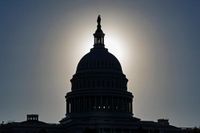More than a week into a grinding government shutdown, the Trump administration has begun an unprecedented wave of layoffs across multiple federal agencies, escalating an already fraught standoff in Washington and sending shockwaves through the nation’s civil service. On October 10, 2025, the Office of Management and Budget (OMB) confirmed that an estimated 4,200 federal employees across at least seven agencies received reduction-in-force (RIF) notices, marking a dramatic departure from the typical furloughs that accompany shutdowns, according to reporting from NPR and the Associated Press.
The layoffs, which administration officials say are necessary to shrink what they describe as a “bloated bureaucracy,” have affected some of the government’s largest and most vital departments. The Treasury Department stands to lose more than 1,400 employees, the Department of Health and Human Services (HHS) over 1,100, and both the Department of Education and the Department of Housing and Urban Development (HUD) more than 400 each. Other agencies impacted include the Departments of Commerce, Energy, and Homeland Security, as well as the Environmental Protection Agency (EPA), with dozens to hundreds of employees at each facing termination.
Word of the layoffs broke late Friday, when OMB Director Russ Vought posted on X, “The RIFs have begun.” In a court filing the same day, OMB senior advisor Stephen Billy described the situation as “fluid and rapidly evolving,” noting that the numbers could change as the shutdown drags on. The declaration was submitted in response to a federal judge’s order in a lawsuit brought by unions challenging the legality of the mass firings.
President Donald Trump, speaking to reporters in the Oval Office, did not mince words about the scale of the cuts. “It’ll be a lot, and we’ll announce the numbers over the next couple of days,” he said. “But it’ll be a lot of people, all because of the Democrats.” Trump also suggested that the layoffs would focus on “Democrat-oriented areas,” though he did not specify what that meant. “These are people that the Democrats wanted, that, in many cases, were not appropriate,” he said, later adding, “Many of them will be fired.”
The administration’s move has drawn swift condemnation from federal employee unions and some lawmakers on both sides of the aisle. The American Federation of Government Employees (AFGE), which represents many affected workers, denounced the firings as an abuse of power. “It is disgraceful that the Trump administration has used the government shutdown as an excuse to illegally fire thousands of workers who provide critical services to communities across the country,” said AFGE National President Everett Kelley in a statement quoted by NPR and AP. The union has filed a lawsuit seeking to halt the layoffs, arguing they violate established laws and historic practice.
Senator Susan Collins, Republican of Maine and chair of the Senate Appropriations Committee, broke ranks with her party to criticize the layoffs. “I strongly oppose OMB Director Russ Vought’s attempt to permanently lay off federal workers who have been furloughed due to a completely unnecessary government shutdown,” Collins said, placing blame for the closure on Senate Minority Leader Chuck Schumer but calling the firings themselves unacceptable. Senator Lisa Murkowski of Alaska echoed these concerns, labeling the move “poorly timed” and “yet another example of this administration’s punitive actions toward the federal workforce.”
Democrats, meanwhile, have accused the Trump administration of using the shutdown as cover for a broader ideological campaign to dismantle parts of the federal government. “Let’s be blunt: nobody’s forcing Trump and Vought to do this,” Schumer said in a statement. “They don’t have to do it; they want to. They’re callously choosing to hurt people—the workers who protect our country, inspect our food, respond when disasters strike. This is deliberate chaos.”
Within the affected agencies, the impact is already being felt. HHS spokesperson Andrew Nixon confirmed that RIF notices were being distributed across multiple divisions, targeting employees designated as non-essential. Nixon blamed the Biden administration for creating a “bloated bureaucracy,” although, according to NPR, HHS had already cut 20,000 workers through earlier RIFs and voluntary departures—more than were added during the previous administration. At the Department of Education, a spokesperson confirmed that almost all employees below the director level at the Office of Elementary and Secondary Education were being let go, with additional cuts at the Office of Communications and Outreach. The union representing Education Department employees accused the administration of “illegally dismantling” the agency against congressional intent.
The Treasury Department, particularly the Internal Revenue Service, has seen employees sharing their layoff notices online, with some given a last working day of December 9. One employee at the Community Development Financial Institutions Fund reported that the entire organization was set to be abolished. At the EPA, union leaders said staff overseeing recycling, plastics reduction, and other environmental programs were among those targeted, warning that “weakening the EPA workforce is a direct threat to the health and safety of Americans.”
Federal law requires agencies to provide at least 60 days’ notice before a RIF, or 30 days if a waiver is granted. Notices must include reasons for the layoff and the effective date, and agencies often must notify unions or Congress in advance. Despite these requirements, the rapid pace and scale of the layoffs have left many workers and their representatives scrambling for answers and recourse.
The administration’s actions are rooted in a broader Department of Government Efficiency initiative launched when Trump returned to office in January 2025. According to NPR, agencies were instructed in February to prepare multi-phase plans for workforce reductions and restructuring, with the goal of implementing the so-called “workforce optimization initiative” by the start of the new fiscal year on October 1. The White House has also frozen transportation funding in major cities and canceled billions in energy project grants as part of its effort to shrink federal operations.
Experts have questioned the necessity of mass layoffs during a shutdown. Jessica Riedl of the Manhattan Institute told NPR, “There is no statute requiring them to lay off a substantial share of federal employees during a temporary government shutdown. That statute doesn’t exist, and such practice has not occurred during previous shutdowns.” Traditionally, furloughed employees are restored to their positions with back pay once funding is restored.
On Capitol Hill, the firings have further soured hopes for a bipartisan solution. Senate Majority Leader John Thune, Republican of South Dakota, defended the administration’s actions, saying, “I think they held off as long as they could.” Still, some Republicans privately acknowledge that the threat of permanent job losses may be complicating negotiations. Senator Collins, for one, insisted, “Regardless of whether federal employees have been working without pay or have been furloughed, their work is incredibly important to serving the public.”
With a court hearing scheduled for October 15 and both parties entrenched, the fate of thousands of federal workers—and the services they provide—hangs in the balance. The shutdown, already the most contentious in recent memory, has now become a test of the limits of executive action in the face of congressional gridlock.
As the days drag on, the uncertainty for federal employees and the country they serve only deepens, with little sign of compromise on the horizon.





